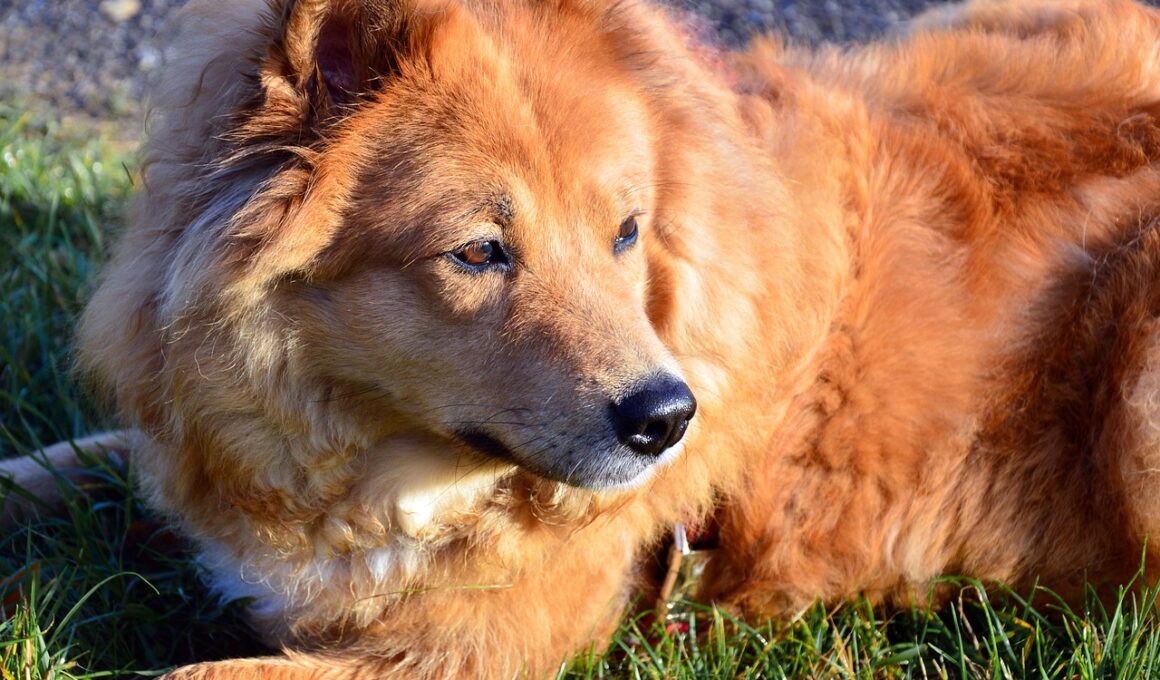Socialization Techniques for Different Dog Breeds in Therapy Work
Therapy dogs play a crucial role in providing comfort and emotional support to individuals in various settings. Understanding that different dog breeds possess distinct temperaments, socialization techniques should be tailored accordingly. For example, Labrador Retrievers, known for their friendliness, thrive in environments where interactions with people are frequent. Techniques like positive reinforcement and controlled exposure to different social situations can enhance their innate sociability. In contrast, breeds such as the Shiba Inu, which can be more aloof, require gradual socialization. They benefit from consistent patience and the introduction of positive experiences with other dogs and people. By recognizing each dog’s unique breed characteristics and behavioral tendencies, handlers can forge more effective training strategies that prepare therapy dogs for various assignments in hospitals, schools, and nursing homes. Effective socialization thus enhances the therapy dog’s capability to provide assistance while ensuring its own comfort. Through gradual exposure to different environments and controlled interactions with people, therapy dogs can learn to effectively engage with those they serve, becoming invaluable due to their calming presence and reliable disposition. Understanding these nuances is essential for anyone training or working with therapy dogs.
Training methodologies also play a significant role in therapy dog socialization. Positive reinforcement techniques are particularly effective, rewarding desired behaviors and ensuring dogs associate social situations with positive outcomes. For instance, when introducing dogs to new environments, using treats, praise, or play as rewards encourages them to engage positively. Additionally, socialization classes can be invaluable. In these classes, therapy dogs can interact with various breeds and people under controlled conditions. This exposure helps develop confidence and reduces anxiety, also fostering adaptability in unpredictable environments. An integral aspect of therapy dog training includes desensitization to stimuli that may cause distress. Quietly introducing dogs to loud noises or busy places gradually can mitigate fear responses, allowing them to remain calm in therapy settings. Each training session should focus on the specific goals relevant to the dog’s breed strengths. For instance, herding breeds might require more mental stimulation or varied activities. Ensuring the therapy dog is both mentally and physically stimulated helps them thrive in their role while maintaining their overall well-being. Effective training can create therapy dogs that are not only well-adjusted but also eager to engage with their clients.
Importance of Consistency and Patience
Consistency and patience are paramount when socializing therapy dogs, especially given the differences in breed temperaments. Some breeds, like Border Collies, are highly trainable and responsive, while others may be slower to adapt. With more independent breeds, such as Bulldogs, handlers must be willing to invest time in cultivating trust through routine. Regular socialization practices not only help in exposing therapy dogs to diverse environments but also assist in honing their skills in dealing with unfamiliar situations. Establishing a predictable training routine ensures dogs know what to expect, fostering a sense of security. Additionally, handlers should maintain patience throughout the process. Frustration can create negative associations, undermining the principles of positive reinforcement training. Progress varies by individual dog and not every lesson will have immediate results. Recognizing small advancements in a dog’s behavior and celebrating them fosters a positive training atmosphere. This ultimately leads to a more competent and confident therapy dog. In such settings, both the handlers and dogs can build a strong bond that enhances their interaction with clients, allowing the dog’s natural abilities to shine while providing emotional support effectively.
Additionally, fostering connections between therapy dogs and potential clients often necessitates engaging in community events. Participating in local gatherings can provide an excellent opportunity for therapy dogs to socialize with large groups of people from various backgrounds. Through potential client interaction at fairs or educational demonstrations, therapy dogs also learn to handle excitement and surprise, becoming more adept at working in public spaces later. This exposure is particularly beneficial to breeds like Golden Retrievers, known for their friendly disposition. Such events teach dogs to remain composed despite the distractions around them. Introducing therapy dogs to diverse experiences can enhance their comfort level, allowing them to engage positively when providing therapeutic interactions. Training with other therapy dogs in a group setting can also foster a collaborative spirit that benefits both the dogs and the handlers. This peer interaction allows dogs to learn from one another, picking up cues that may improve their own social skills. The dogs can also practice their skills in a controlled environment. Such exposure is instrumental for helping therapy dogs realize their purpose within therapeutic environments, ensuring they are effective in their roles.
Specific Needs of Different Breeds
Understanding the specific needs of different breeds helps significantly in tailoring training methods for therapy work. For instance, small breed dogs like Chihuahuas may require additional socialization to help them overcome their natural timidness. Gradual exposure to larger dogs and unknown sounds can build their confidence. In contrast, large breeds such as Great Danes need reassurance and clear commands to help them behave appropriately in therapy situations. Their large size can intimidate some individuals, making it essential for handlers to train these dogs in gentle handling techniques. Adapting training protocols to accommodate various breed characteristics fosters a more effective learning environment. Tailoring techniques to fit each dog’s attributes maximizes their potential, ensuring they can serve in therapy roles effectively. Furthermore, understanding these characteristics aids in developing individualized therapy programs that cater to the needs of clients. It’s crucial to ensure that each dog remains comfortable and engaged, maintaining a positive attitude throughout the training process. This practice ultimately leads to well-balanced therapy dogs that can thrive in their roles and provide exceptional support to those in need.
Handlers should also engage in continuous learning and development in training techniques. Attending workshops or seminars focused on dog training provides an opportunity to glean insights and knowledge about effective practices. Keeping up to date with the latest research in dog behavior, socialization methods, and training techniques can greatly enhance handlers’ effectiveness in interacting with their dogs. Sharing experiences with other therapy dog handlers not only fosters a supportive community, but also introduces diverse methodologies, expanding their toolkit for training techniques. Another aspect of continuous learning involves understanding canine body language. Recognizing stress signals or signs of comfort in dogs enables handlers to intervene promptly, ensuring a safe and positive environment for everyone involved. Training and socialization are ongoing processes that evolve as new challenges arise, requiring flexibility and responsiveness from handlers. The relationship built through continued education between handlers and therapy dogs ultimately leads to better outcomes in therapeutic settings. By remaining dedicated to enhancing their knowledge, handlers create the optimal atmosphere for their therapy dogs to succeed while providing compassionate support to those they aim to help.
Final Thoughts on Therapy Dog Socialization
The journey of socialization for therapy dogs is essential for their effectiveness in providing emotional support. By understanding the unique characteristics of each breed, handlers can employ tailored socialization techniques and training protocols that foster positive interactions with clients. Every dog has the potential to shine in their unique role, whether they are large breeds or small. The focus on consistency and patience, as well as community engagement, further enhances the learning experience for therapy dogs, allowing them to thrive in dynamic environments. Throughout this process, handlers must remain observant and flexible, adjusting their methods to the needs of each dog, ensuring a positive experience for both the dog and those they assist. This adaptability is pivotal, as each therapy dog is as unique as those they serve. Ultimately, the outcome relies on a bond of trust established through successful socialization, leading to positive emotional connections in therapy settings. The responsibility lies with the handlers to unlock this potential, ensuring therapy dogs become invaluable companions for individuals in need of support, thereby maximizing their impact on the lives they touch.
Through continued dedication to training and socialization, handlers create a solid foundation that enables therapy dogs and their clients to share meaningful, transformative moments together. Each session, interaction, and experience contributes to building a well-rounded therapy dog ready to provide comfort and companionship. To facilitate this process, utilizing resources such as training manuals, expert advice, and attending relevant classes can significantly enhance the training journey. Engaging in networking with other handlers provides an additional layer of support, giving dogs and their handlers insights into shared experiences. Recognizing that every dog specializes as a therapy dog will allow handlers to emphasize their unique strengths. The growth in this relationship ensures a lasting partnership that delivers benefits to both parties. This journey enhances dogs’ abilities to perform their therapeutic roles effectively while fostering stronger human-animal bonds. As handlers guide their therapy dogs through the complexities of human interactions, they teach them essential skills for being truly present for those they serve. With that bond established, therapy dogs become more than just trained companions. They grow into integral parts of the emotional healing process for many in challenging situations.


